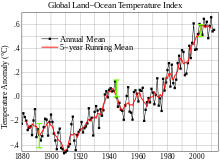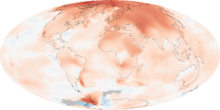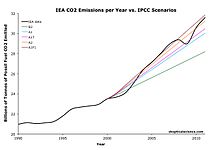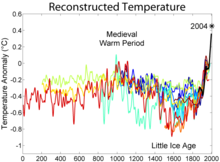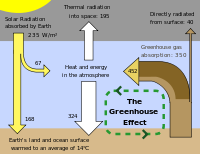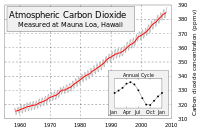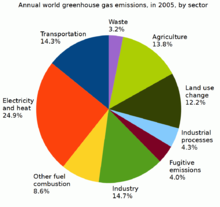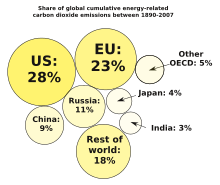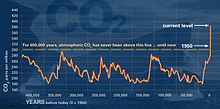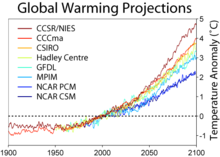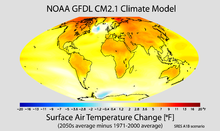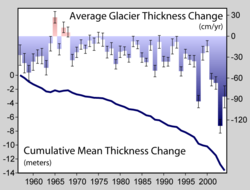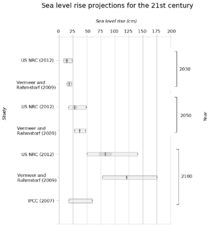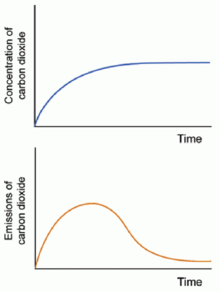
Global warming
About this schools Wikipedia selection
This selection is made for schools by a children's charity read more. SOS Children is the world's largest charity giving orphaned and abandoned children the chance of family life.
Global warming is the rise in the average temperature of Earth's atmosphere and oceans since the late 19th century and its projected continuation. Since the early 20th century, Earth's mean surface temperature has increased by about 0.8 °C (1.4 °F), with about two-thirds of the increase occurring since 1980. Warming of the climate system is unequivocal, and scientists are more than 90% certain that it is primarily caused by increasing concentrations of greenhouse gases produced by human activities such as the burning of fossil fuels and deforestation. These findings are recognized by the national science academies of all major industrialized nations.
Climate model projections were summarized in the 2007 Fourth Assessment Report (AR4) by the Intergovernmental Panel on Climate Change (IPCC). They indicated that during the 21st century the global surface temperature is likely to rise a further 1.1 to 2.9 °C (2 to 5.2 °F) for their lowest emissions scenario and 2.4 to 6.4 °C (4.3 to 11.5 °F) for their highest. The ranges of these estimates arise from the use of models with differing sensitivity to greenhouse gas concentrations.
Future warming and related changes will vary from region to region around the globe. The effects of an increase in global temperature include a rise in sea levels and a change in the amount and pattern of precipitation, as well a probable expansion of subtropical deserts. Warming is expected to be strongest in the Arctic and would be associated with the continuing retreat of glaciers, permafrost and sea ice. Other likely effects of the warming include a more frequent occurrence of extreme-weather events including heat waves, droughts and heavy rainfall, ocean acidification and species extinctions due to shifting temperature regimes. Effects significant to humans include the threat to food security from decreasing crop yields and the loss of habitat from inundation.
Proposed policy responses to global warming include mitigation by emissions reduction, adaptation to its effects, and possible future geoengineering. Most countries are parties to the United Nations Framework Convention on Climate Change (UNFCCC), whose ultimate objective is to prevent dangerous anthropogenic (i.e., human-induced) climate change. Parties to the UNFCCC have adopted a range of policies designed to reduce greenhouse gas emissions and to assist in adaptation to global warming. Parties to the UNFCCC have agreed that deep cuts in emissions are required, and that future global warming should be limited to below 2.0 °C (3.6 °F) relative to the pre-industrial level. Reports published in 2011 by the United Nations Environment Programme and the International Energy Agency suggest that efforts as of the early 21st century to reduce emissions may be inadequate to meet the UNFCCC's 2 °C target.
Observed temperature changes
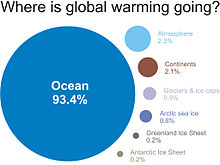
The Earth's average surface temperature rose by 0.74±0.18 °C over the period 1906–2005. The rate of warming over the last half of that period was almost double that for the period as a whole (0.13±0.03 °C per decade, versus 0.07±0.02 °C per decade). The urban heat island effect is very small, estimated to account for less than 0.002 °C of warming per decade since 1900. Temperatures in the lower troposphere have increased between 0.13 and 0.22 °C (0.22 and 0.4 °F) per decade since 1979, according to satellite temperature measurements. Climate proxies show the temperature to have been relatively stable over the one or two thousand years before 1850, with regionally varying fluctuations such as the Medieval Warm Period and the Little Ice Age.
The warming that is evident in the instrumental temperature record is consistent with a wide range of observations, as documented by many independent scientific groups. Examples include sea level rise (water expands as it warms), widespread melting of snow and ice, increased heat content of the oceans, increased humidity, and the earlier timing of spring events, e.g., the flowering of plants. The probability that these changes could have occurred by chance is virtually zero.
Recent estimates by NASA's Goddard Institute for Space Studies (GISS) and the National Climatic Data Centre show that 2005 and 2010 tied for the planet's warmest year since reliable, widespread instrumental measurements became available in the late 19th century, exceeding 1998 by a few hundredths of a degree. Estimates by the Climatic Research Unit (CRU) show 2005 as the second warmest year, behind 1998 with 2003 and 2010 tied for third warmest year, however, "the error estimate for individual years ... is at least ten times larger than the differences between these three years." The World Meteorological Organization (WMO) statement on the status of the global climate in 2010 explains that, "The 2010 nominal value of +0.53 °C ranks just ahead of those of 2005 (+0.52 °C) and 1998 (+0.51 °C), although the differences between the three years are not statistically significant..."
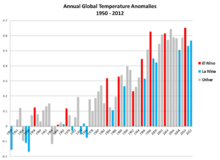
Temperatures in 1998 were unusually warm because global temperatures are affected by the El Niño-Southern Oscillation (ENSO), and the strongest El Niño in the past century occurred during that year. Global temperature is subject to short-term fluctuations that overlay long term trends and can temporarily mask them. The relative stability in temperature from 2002 to 2009 is consistent with such an episode. 2010 was also an El Niño year. On the low swing of the oscillation, 2011 as an La Niña year was cooler but it was still the 11th warmest year since records began in 1880. Of the 13 warmest years since 1880, 11 were the years from 2001 to 2011. Over the more recent record, 2011 was the warmest La Niña year in the period from 1950 to 2011, and was close to 1997 which was not at the lowest point of the cycle.
Temperature changes vary over the globe. Since 1979, land temperatures have increased about twice as fast as ocean temperatures (0.25 °C per decade against 0.13 °C per decade). Ocean temperatures increase more slowly than land temperatures because of the larger effective heat capacity of the oceans and because the ocean loses more heat by evaporation. The northern hemisphere warms faster than the southern hemisphere because it has more land and because it has extensive areas of seasonal snow and sea-ice cover subject to ice-albedo feedback. Although more greenhouse gases are emitted in the Northern than Southern Hemisphere this does not contribute to the difference in warming because the major greenhouse gases persist long enough to mix between hemispheres.
The thermal inertia of the oceans and slow responses of other indirect effects mean that climate can take centuries or longer to adjust to changes in forcing. Climate commitment studies indicate that even if greenhouse gases were stabilized at 2000 levels, a further warming of about 0.5 °C (0.9 °F) would still occur.
Initial causes of temperature changes (external forcings)
The climate system can respond to changes in external forcings. External forcings can "push" the climate in the direction of warming or cooling. Examples of external forcings include changes in atmospheric composition (e.g., increased concentrations of greenhouse gases), solar luminosity, volcanic eruptions, and variations in Earth's orbit around the Sun. Orbital cycles vary slowly over tens of thousands of years and at present are in an overall cooling trend which would be expected to lead towards an ice age, but the 20th century instrumental temperature record shows a sudden rise in global temperatures.
Greenhouse gases
The greenhouse effect is the process by which absorption and emission of infrared radiation by gases in the atmosphere warm a planet's lower atmosphere and surface. It was proposed by Joseph Fourier in 1824 and was first investigated quantitatively by Svante Arrhenius in 1896.
Naturally occurring amounts of greenhouse gases have a mean warming effect of about 33 °C (59 °F). The major greenhouse gases are water vapor, which causes about 36–70% of the greenhouse effect; carbon dioxide (CO2), which causes 9–26%; methane (CH4), which causes 4–9%; and ozone (O3), which causes 3–7%. Clouds also affect the radiation balance through cloud forcings similar to greenhouse gases.
Human activity since the Industrial Revolution has increased the amount of greenhouse gases in the atmosphere, leading to increased radiative forcing from CO2, methane, tropospheric ozone, CFCs and nitrous oxide. The concentrations of CO2 and methane have increased by 36% and 148% respectively since 1750. These levels are much higher than at any time during the last 800,000 years, the period for which reliable data has been extracted from ice cores. Less direct geological evidence indicates that CO2 values higher than this were last seen about 20 million years ago. Fossil fuel burning has produced about three-quarters of the increase in CO2 from human activity over the past 20 years. The rest of this increase is caused mostly by changes in land-use, particularly deforestation.
Over the last three decades of the 20th century, gross domestic product per capita and population growth were the main drivers of increases in greenhouse gas emissions. CO2 emissions are continuing to rise due to the burning of fossil fuels and land-use change. Emissions can be attributed to different regions, e.g., see the figure opposite. Attribution of emissions due to land-use change is a controversial issue.
Emissions scenarios, estimates of changes in future emission levels of greenhouse gases, have been projected that depend upon uncertain economic, sociological, technological, and natural developments. In most scenarios, emissions continue to rise over the century, while in a few, emissions are reduced. Fossil fuel reserves are abundant, and will not limit carbon emissions in the 21st century. Emission scenarios, combined with modelling of the carbon cycle, have been used to produce estimates of how atmospheric concentrations of greenhouse gases might change in the future. Using the six IPCC SRES "marker" scenarios, models suggest that by the year 2100, the atmospheric concentration of CO2 could range between 541 and 970 ppm. This is an increase of 90–250% above the concentration in the year 1750.
The popular media and the public often confuse global warming with ozone depletion, i.e., the destruction of stratospheric ozone by chlorofluorocarbons. Although there are a few areas of linkage, the relationship between the two is not strong. Reduced stratospheric ozone has had a slight cooling influence on surface temperatures, while increased tropospheric ozone has had a somewhat larger warming effect.
Particulates and soot
Global dimming, a gradual reduction in the amount of global direct irradiance at the Earth's surface, was observed from 1961 until at least 1990. The main cause of this dimming is particulates produced by volcanoes and human made pollutants, which exerts a cooling effect by increasing the reflection of incoming sunlight. The effects of the products of fossil fuel combustion – CO2 and aerosols – have largely offset one another in recent decades, so that net warming has been due to the increase in non-CO2 greenhouse gases such as methane. Radiative forcing due to particulates is temporally limited due to wet deposition which causes them to have an atmospheric lifetime of one week. Carbon dioxide has a lifetime of a century or more, and as such, changes in particulate concentrations will only delay climate changes due to carbon dioxide.
In addition to their direct effect by scattering and absorbing solar radiation, particulates have indirect effects on the radiation budget. Sulfates act as cloud condensation nuclei and thus lead to clouds that have more and smaller cloud droplets. These clouds reflect solar radiation more efficiently than clouds with fewer and larger droplets, known as the Twomey effect. This effect also causes droplets to be of more uniform size, which reduces growth of raindrops and makes the cloud more reflective to incoming sunlight, known as the Albrecht effect. Indirect effects are most noticeable in marine stratiform clouds, and have very little radiative effect on convective clouds. Indirect effects of particulates represent the largest uncertainty in radiative forcing.
Soot may cool or warm the surface, depending on whether it is airborne or deposited. Atmospheric soot directly absorb solar radiation, which heats the atmosphere and cools the surface. In isolated areas with high soot production, such as rural India, as much as 50% of surface warming due to greenhouse gases may be masked by atmospheric brown clouds. When deposited, especially on glaciers or on ice in arctic regions, the lower surface albedo can also directly heat the surface. The influences of particulates, including black carbon, are most pronounced in the tropics and sub-tropics, particularly in Asia, while the effects of greenhouse gases are dominant in the extratropics and southern hemisphere.

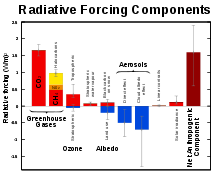
Solar activity
Since 1978, output from the Sun has been precisely measured by satellites. These measurements indicate that the Sun's output has not increased since 1978, so the warming during the past 30 years cannot be attributed to an increase in solar energy reaching the Earth. In the three decades since 1978, the combination of solar and volcanic activity probably had a slight cooling influence on the climate.
Climate models have been used to examine the role of the sun in recent climate change. Models are unable to reproduce the rapid warming observed in recent decades when they only take into account variations in solar output and volcanic activity. Models are, however, able to simulate the observed 20th century changes in temperature when they include all of the most important external forcings, including human influences and natural forcings.
Another line of evidence against the sun having caused recent climate change comes from looking at how temperatures at different levels in the Earth's atmosphere have changed. Models and observations show that greenhouse warming results in warming of the lower atmosphere (called the troposphere) but cooling of the upper atmosphere (called the stratosphere). Depletion of the ozone layer by chemical refrigerants has also resulted in a strong cooling effect in the stratosphere. If the sun was responsible for observed warming, warming of both the troposphere and stratosphere would be expected.
Feedback
The climate system includes a range of feedbacks which alter the response of the system to changes in external forcings. Positive feedbacks increase the response of the climate system to an initial forcing, while negative feedbacks reduce the response of the climate system to an initial forcing.
There are a range of feedbacks in the climate system, including water vapor, changes in ice-albedo (snow and ice cover affect how much the Earth's surface absorbs or reflects incoming sunlight), clouds, and changes in the Earth's carbon cycle (e.g., the release of carbon from soil). The main negative feedback is the energy which the Earth's surface radiates into space as infrared radiation. According to the Stefan-Boltzmann law, if temperature doubles, radiated energy increases by a factor of 16 (2 to the 4th power).
Feedbacks are an important factor in determining the sensitivity of the climate system to increased atmospheric greenhouse gas concentrations. Other factors being equal, a higher climate sensitivity means that more warming will occur for a given increase in greenhouse gas forcing. Uncertainty over the effect of feedbacks is a major reason why different climate models project different magnitudes of warming for a given forcing scenario. More research is needed to understand the role of clouds and carbon cycle feedbacks in climate projections.
The IPCC projections given in the lede span the "likely" range (greater than 66% probability, based on expert judgement) for the selected emissions scenarios. However, the IPCC's projections do not reflect the full range of uncertainty. The lower end of the "likely" range appears to be better constrained than the upper end of the "likely" range.
Climate models
A climate model is a computerized representation of the five components of the climate system: Atmosphere, hydrosphere, cryosphere, land surface, and biosphere. Such models are based on physical principles including fluid dynamics, thermodynamics and radiative transfer. There can be components which represent air movement, temperature, clouds, and other atmospheric properties; ocean temperature, salt content, and circulation; ice cover on land and sea; the transfer of heat and moisture from soil and vegetation to the atmosphere; chemical and biological processes; and others.
Although researchers attempt to include as many processes as possible, simplifications of the actual climate system are inevitable because of the constraints of available computer power and limitations in knowledge of the climate system. Results from models can also vary due to different greenhouse gas inputs and the model's climate sensitivity. For example, the uncertainty in IPCC's 2007 projections is caused by (1) the use of multiple models with differing sensitivity to greenhouse gas concentrations, (2) the use of differing estimates of humanities' future greenhouse gas emissions, (3) any additional emissions from climate feedbacks that were not included in the models IPCC used to prepare its report, i.e., greenhouse gas releases from permafrost.
The models do not assume the climate will warm due to increasing levels of greenhouse gases. Instead the models predict how greenhouse gases will interact with radiative transfer and other physical processes. One of the mathematical results of these complex equations is a prediction whether warming or cooling will occur.
Recent research has called special attention to the need to refine models with respect to the effect of clouds and the carbon cycle.
Models are also used to help investigate the causes of recent climate change by comparing the observed changes to those that the models project from various natural and human-derived causes. Although these models do not unambiguously attribute the warming that occurred from approximately 1910 to 1945 to either natural variation or human effects, they do indicate that the warming since 1970 is dominated by man-made greenhouse gas emissions.
The physical realism of models is tested by examining their ability to simulate contemporary or past climates.
Climate models produce a good match to observations of global temperature changes over the last century, but do not simulate all aspects of climate. Not all effects of global warming are accurately predicted by the climate models used by the IPCC. Observed Arctic shrinkage has been faster than that predicted. Precipitation increased proportional to atmospheric humidity, and hence significantly faster than global climate models predict.
Observed and expected environmental effects
"Detection" is the process of demonstrating that climate has changed in some defined statistical sense, without providing a reason for that change. Detection does not imply attribution of the detected change to a particular cause. "Attribution" of causes of climate change is the process of establishing the most likely causes for the detected change with some defined level of confidence. Detection and attribution may also be applied to observed changes in physical, ecological and social systems.
Natural systems
Global warming has been detected in a number of natural systems. Some of these changes are described in the section on observed temperature changes, e.g., sea level rise and widespread decreases in snow and ice extent. Anthropogenic forcing has likely contributed to some of the observed changes, including sea level rise, changes in climate extremes (such as the number of warm and cold days), declines in Arctic sea ice extent, and to glacier retreat.
Projections of sea level rise over the 21st century are shown opposite. On the timescale of centuries to millennia, the melting of ice sheets could result in even higher sea level rise. Partial deglaciation of the Greenland ice sheet, and possibly the West Antarctic Ice Sheet, could contribute 4–6 metres (13 to 20 ft) or more to sea level rise.
Changes in regional climate are expected to include greater warming over land, with most warming at high northern latitudes, and least warming over the Southern Ocean and parts of the North Atlantic Ocean. During the 21st century, glaciers and snow cover are projected to continue their widespread retreat. Projections of declines in Arctic sea ice vary. Recent projections suggest that Arctic summers could be ice-free (defined as ice extent less than 1 million square km) as early as 2025-2030.
Future changes in precipitation are expected to follow existing trends, with reduced precipitation over subtropical land areas, and increased precipitation at subpolar latitudes and some equatorial regions. Projections suggest a probable increase in the frequency and severity of some extreme weather events, such as heat waves.
Ecological systems
In terrestrial ecosystems, the earlier timing of spring events, and poleward and upward shifts in plant and animal ranges, have been linked with high confidence to recent warming. Future climate change is expected to particularly affect certain ecosystems, including tundra, mangroves, and coral reefs. It is expected that most ecosystems will be affected by higher atmospheric CO2 levels, combined with higher global temperatures. Overall, it is expected that climate change will result in the extinction of many species and reduced diversity of ecosystems.
Dissolved CO2 increases ocean acidity. This process is known as ocean acidification and has been called the "equally evil twin" of global climate change. Increased ocean acidity decreases the amount of carbonate ions, which organisms at the base of the marine food chain, such as foraminifera, use to make structures they need to survive. The current rate of ocean acidification is many times faster than at least the past 300 million years, which included four mass extinctions that involved rising ocean acidity, such as the Permian mass extinction, which killed 95% of marine species. By the end of the century, acidity changes since the industrial revolution would match the Palaeocene-Eocene Thermal Maximum, which occurred over 5000 years and killed 35–50% of benthic foraminifera.
Large-scale and abrupt impacts
Climate change could result in global, large-scale changes in natural and social systems. Two examples are ocean acidification caused by increased atmospheric concentrations of carbon dioxide, and the long-term melting of ice sheets, which contributes to sea level rise.
Some large-scale changes could occur abruptly, i.e., over a short time period, and might also be irreversible. An example of abrupt climate change is the rapid release of methane from permafrost, which would lead to amplified global warming. Scientific understanding of abrupt climate change is generally poor. However, the probability of abrupt changes appears to be very low. Factors that may increase the probability of abrupt climate change include higher magnitudes of global warming, warming that occurs more rapidly, and warming that is sustained over longer time periods.
Observed and expected effects on social systems
Vulnerability of human societies to climate change mainly lies in the effects of extreme-weather events rather than gradual climate change. Impacts of climate change so far include adverse effects on small islands, adverse effects on indigenous populations in high-latitude areas, and small but discernable effects on human health. Over the 21st century, climate change is likely to adversely affect hundreds of millions of people through increased coastal flooding, reductions in water supplies, increased malnutrition and increased health impacts. Most economic studies suggest losses of world gross domestic product (GDP) for this magnitude of warming.
Food security
Under present trends, by 2030, maize production in Southern Africa could decrease by up to 30% while rice, millet and maize in South Asia could decrease by up to 10%. By 2080, yields in developing countries could decrease by 10% to 25% on average while India could see a drop of 30% to 40%. By 2100, while the population of three billion is expected to double, rice and maize yields in the tropics are expected to decrease by 20–40% because of higher temperatures without accounting for the decrease in yields as a result of soil moisture and water supplies stressed by rising temperatures.
Future warming of around 3 °C (by 2100, relative to 1990–2000) could result in increased crop yields in mid- and high-latitude areas, but in low-latitude areas, yields could decline, increasing the risk of malnutrition. A similar regional pattern of net benefits and costs could occur for economic ( market-sector) effects. Warming above 3 °C could result in crop yields falling in temperate regions, leading to a reduction in global food production.
Habitat inundation
In small islands and megadeltas, inundation as a result of sea level rise is expected to threaten vital infrastructure and human settlements. This could lead to issues of statelessness for populations in countries such as the Maldives and Tuvalu and homelessness in countries with low lying areas such as Bangladesh.
Responses to global warming
Mitigation
Reducing the amount of future climate change is called mitigation of climate change. The IPCC defines mitigation as activities that reduce greenhouse gas (GHG) emissions, or enhance the capacity of carbon sinks to absorb GHGs from the atmosphere. Studies indicate substantial potential for future reductions in emissions by a combination of emission-reducing activities such as energy conservation, increased energy efficiency, and satisfying more of society's power demands with renewable energy and/or nuclear energy sources. Climate mitigation also includes acts to enhance natural sinks, such as reforestation.
In order to limit warming to within the lower range described in the IPCC's "Summary Report for Policymakers" it will be necessary to adopt policies that will limit greenhouse gas emissions to one of several significantly different scenarios described in the full report. This will become more and more difficult with each year of increasing volumes of emissions and even more drastic measures will be required in later years to stabilize a desired atmospheric concentration of greenhouse gases. Energy-related carbon-dioxide (CO2) emissions in 2010 were the highest in history, breaking the prior record set in 2008.
Adaptation
Other policy responses include adaptation to climate change. Adaptation to climate change may be planned, either in reaction to or anticipation of climate change, or spontaneous, i.e., without government intervention. Planned adaptation is already occurring on a limited basis. The barriers, limits, and costs of future adaptation are not fully understood.
A concept related to adaptation is " adaptive capacity," which is the ability of a system (human, natural or managed) to adjust to climate change (including climate variability and extremes) to moderate potential damages, to take advantage of opportunities, or to cope with consequences. Unmitigated climate change (i.e., future climate change without efforts to limit greenhouse gas emissions) would, in the long term, be likely to exceed the capacity of natural, managed and human systems to adapt.
Views on global warming
There are different views over what the appropriate policy response to climate change should be. These competing views weigh the benefits of limiting emissions of greenhouse gases against the costs. In general, it seems likely that climate change will impose greater damages and risks in poorer regions.
Global warming controversy
The global warming controversy refers to a variety of disputes, significantly more pronounced in the popular media than in the scientific literature, regarding the nature, causes, and consequences of global warming. The disputed issues include the causes of increased global average air temperature, especially since the mid-20th century, whether this warming trend is unprecedented or within normal climatic variations, whether humankind has contributed significantly to it, and whether the increase is wholly or partially an artifact of poor measurements. Additional disputes concern estimates of climate sensitivity, predictions of additional warming, and what the consequences of global warming will be.
In the scientific literature, there is a strong consensus that global surface temperatures have increased in recent decades and that the trend is caused mainly by human-induced emissions of greenhouse gases. No scientific body of national or international standing disagrees with this view, though a few organisations hold non-committal positions.
From 1990–1997 in the United States, conservative think tanks mobilized to undermine the legitimacy of global warming as a social problem. They challenged the scientific evidence; argued that global warming will have benefits; and asserted that proposed solutions would do more harm than good.
Politics
Most countries are Parties to the United Nations Framework Convention on Climate Change (UNFCCC). The ultimate objective of the Convention is to prevent dangerous human interference of the climate system. As is stated in the Convention, this requires that GHG concentrations are stabilized in the atmosphere at a level where ecosystems can adapt naturally to climate change, food production is not threatened, and economic development can proceed in a sustainable fashion. The Framework Convention was agreed in 1992, but since then, global emissions have risen. During negotiations, the G77 (a lobbying group in the United Nations representing 133 developing nations) pushed for a mandate requiring developed countries to "[take] the lead" in reducing their emissions. This was justified on the basis that: the developed world's emissions had contributed most to the stock of GHGs in the atmosphere; per-capita emissions (i.e., emissions per head of population) were still relatively low in developing countries; and the emissions of developing countries would grow to meet their development needs. This mandate was sustained in the Kyoto Protocol to the Framework Convention, which entered into legal effect in 2005.
In ratifying the Kyoto Protocol, most developed countries accepted legally binding commitments to limit their emissions. These first-round commitments expire in 2012. US President George W. Bush rejected the treaty on the basis that "it exempts 80% of the world, including major population centers such as China and India, from compliance, and would cause serious harm to the US economy."
At the 15th UNFCCC Conference of the Parties, held in 2009 at Copenhagen, several UNFCCC Parties produced the Copenhagen Accord. Parties associated with the Accord (140 countries, as of November 2010) aim to limit the future increase in global mean temperature to below 2 °C. A preliminary assessment published in November 2010 by the United Nations Environment Programme (UNEP) suggests a possible "emissions gap" between the voluntary pledges made in the Accord and the emissions cuts necessary to have a "likely" (greater than 66% probability) chance of meeting the 2 °C objective. The UNEP assessment takes the 2 °C objective as being measured against the pre-industrial global mean temperature level. To having a likely chance of meeting the 2 °C objective, assessed studies generally indicated the need for global emissions to peak before 2020, with substantial declines in emissions thereafter.
The 16th Conference of the Parties (COP16) was held at Cancún in 2010. It produced an agreement, not a binding treaty, that the Parties should take urgent action to reduce greenhouse gas emissions to meet a goal of limiting global warming to 2 °C above pre-industrial temperatures. It also recognized the need to consider strengthening the goal to a global average rise of 1.5 °C.
Public opinion
In 2007–2008 Gallup Polls surveyed 127 countries. Over a third of the world's population was unaware of global warming, with people in developing countries less aware than those in developed, and those in Africa the least aware. Of those aware, Latin America leads in belief that temperature changes are a result of human activities while Africa, parts of Asia and the Middle East, and a few countries from the Former Soviet Union lead in the opposite belief. In the Western world, opinions over the concept and the appropriate responses are divided. Nick Pidgeon of Cardiff University said that "results show the different stages of engagement about global warming on each side of the Atlantic", adding, "The debate in Europe is about what action needs to be taken, while many in the US still debate whether climate change is happening." A 2010 poll by the Office of National Statistics found that 75% of UK respondents were at least "fairly convinced" that the world's climate is changing, compared to 87% in a similar survey in 2006. A January 2011 ICM poll in the UK found 83% of respondents viewed climate change as a current or imminent threat, while 14% said it was no threat. Opinion was unchanged from an August 2009 poll asking the same question, though there had been a slight polarisation of opposing views.
A survey in October 2009 by the Pew Research Centre for the People & the Press showed decreasing public perception in the US that global warming was a serious problem. All political persuasions showed reduced concern with lowest concern among Republicans, only 35% of whom considered there to be solid evidence of global warming. The cause of this marked difference in public opinion between the US and the global public is uncertain but the hypothesis has been advanced that clearer communication by scientists both directly and through the media would be helpful in adequately informing the American public of the scientific consensus and the basis for it. The US public appears to be unaware of the extent of scientific consensus regarding the issue, with 59% believing that scientists disagree "significantly" on global warming.
By 2010, with 111 countries surveyed, Gallup determined that there was a substantial decrease in the number of Americans and Europeans who viewed Global Warming as a serious threat. In the US, a little over half the population (53%) now viewed it as a serious concern for either themselves or their families; this was 10% below the 2008 poll (63%). Latin America had the biggest rise in concern, with 73% saying global warming was a serious threat to their families. That global poll also found that people are more likely to attribute global warming to human activities than to natural causes, except in the USA where nearly half (47%) of the population attributed global warming to natural causes.
On the other hand, in May 2011 a joint poll by Yale and George Mason Universities found that nearly half the people in the USA (47%) attribute global warming to human activities, compared to 36% blaming it on natural causes. Only 5% of the 35% who were "disengaged", "doubtful", or "dismissive" of global warming were aware that 97% of publishing US climate scientists agree global warming is happening and is primarily caused by humans.
Researchers at the University of Michigan have found that the public's belief as to the causes of global warming depends on the wording choice used in the polls.
In the United States, according to the Public Policy Institute of California's (PPIC) eleventh annual survey on environmental policy issues, 75% said they believe global warming is a very serious or somewhat serious threat to the economy and quality of life in California.
A September 2011 Angus Reid Public Opinion poll found that Britons (43%) are less likely than Americans (49%) or Canadians (52%) to say that "global warming is a fact and is mostly caused by emissions from vehicles and industrial facilities." The same poll found that 20% of Americans, 20% of Britons and 14% of Canadians think "global warming is a theory that has not yet been proven."
Other views
Most scientists agree that humans are contributing to observed climate change. National science academies have called on world leaders for policies to cut global emissions. However, some scientists and non-scientists question aspects of climate-change science, see: list of scientists opposing global warming consensus.
Organizations such as the libertarian Competitive Enterprise Institute, conservative commentators, and some companies such as ExxonMobil have challenged IPCC climate change scenarios, funded scientists who disagree with the scientific consensus, and provided their own projections of the economic cost of stricter controls. In the finance industry, Deutsche Bank has set up an institutional climate change investment division (DBCCA), which has commissioned and published research on the issues and debate surrounding global warming. Environmental organizations and public figures have emphasized changes in the climate and the risks they entail, while promoting adaptation to changes in infrastructural needs and emissions reductions. Some fossil fuel companies have scaled back their efforts in recent years, or called for policies to reduce global warming.
Etymology
The term global warming was probably first used in its modern sense on 8 August 1975 in a science paper by Wally Broecker in the journal Science called "Are we on the brink of a pronounced global warming?". Broecker's choice of words was new and represented a significant recognition that the climate was warming; previously the phrasing used by scientists was "inadvertent climate modification," because while it was recognized humans could change the climate, no one was sure which direction it was going. The National Academy of Sciences first used global warming in a 1979 paper called the Charney Report, which said: "if carbon dioxide continues to increase, [we find] no reason to doubt that climate changes will result and no reason to believe that these changes will be negligible." The report made a distinction between referring to surface temperature changes as global warming, while referring to other changes caused by increased CO2 as climate change.
Global warming became more widely popular after 1988 when NASA climate scientist James Hansen used the term in a testimony to Congress. He said: "global warming has reached a level such that we can ascribe with a high degree of confidence a cause and effect relationship between the greenhouse effect and the observed warming." His testimony was widely reported and afterward global warming was commonly used by the press and in public discourse.
